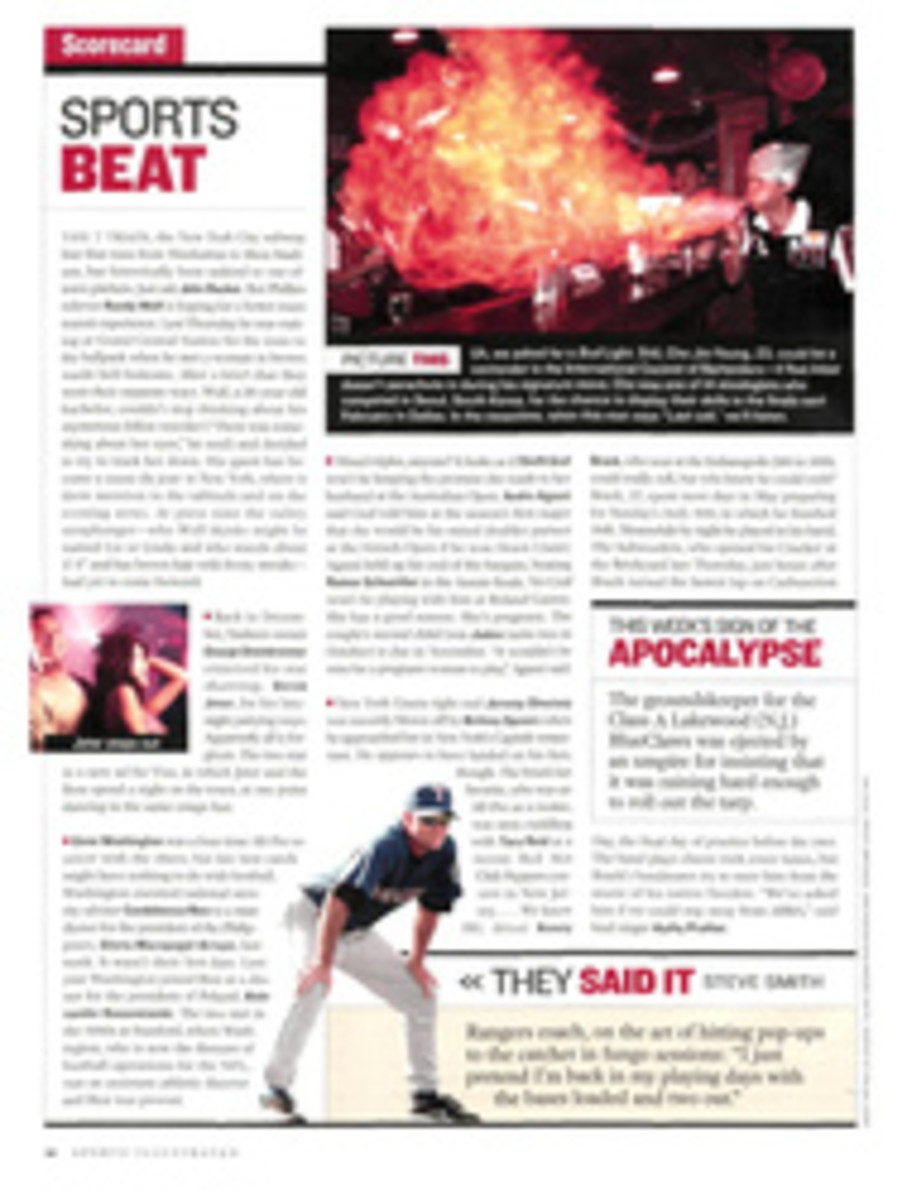
As Scary As He Looks With all the props of the archetypal closer-as-intimidator, Eric Gagne was a ferocious force as the Dodgers rolled to 10 straight wins
One eighteenth of a ball game belongs to Eric Gagne, and in that
fraction he defines himself. "I'm me on the mound," the Los
Angeles Dodgers' closer says. "I like to show my emotion, be real
aggressive and give everything I've got for one half inning. I
don't have to act. What you see on the mound is what I am in real
life." ¶ With his headbanger's demeanor, menacing entrance--the
bullpen gate swings open like a saloon door and an
eardrum-thrumming Guns N' Roses riff blares over the P.A. system
as he walks slowly to the mound--and two near-unhittable pitches,
Gagne has fast become baseball's most overpowering finisher. Through
Sunday he had been brought in to save 74 games since April 2002
and had done so 70 times; he also had a 1.93 ERA and 13.3
strikeouts per nine innings, the best strikeout rate in the
majors over that span. "Not only does he go out and get it done,"
says Dodgers manager Jim Tracy, "but he gets it done with such
devastation. That's how he's built a reputation so quickly."
On May 16, against the Florida Marlins, Gagne began a virtuoso
stretch in which he would retire 18 of 19 batters, 14 of them by
strikeout, and save six consecutive games as Los Angeles won 10
straight and gained a tie for first place with the San Francisco
Giants in the National League West. A chill wind whipped through
Dodger Stadium that night as Gagne toddled in from the bullpen to
Welcome to the Jungle, looking as if he were walking off a
B-movie production lot in Burbank. His uniform shirt untucked,
his cap crammed low over Oakley goggles, an underbrush of goatee
around his chin, Gagne finished his warmups as Axl Rose let loose
a protracted howl. "There's something about putting on the
closer's clothes that gives Eric a special armor of
invincibility," says pitching coach Jim Colborn. "The music, the
demeanor, the style--he's not just a pitcher coming out of the
pen, there's an aura coming with him."
Gagne madly windmilled his right arm and then threw baby jabs
with his bare right hand as he pawed at the mound with his
spikes. Like all of his childhood friends in Mascouche, Que., an
eastern suburb of Montreal, Gagne played hockey. He was a burly
defenseman always up for a fight--he compares himself with Derian
Hatcher, the snarling Dallas Stars captain--and when he flexes
his knuckles, he displays a crisscross of white scars.
Gagne golfs for fun but admits to having broken three or four
clubs and pitched as many into lakes. During one minor league
season he was ejected five times for throwing beanballs. "He's an
ornery guy," says Lloyd Simmons, Gagne's coach at Seminole
(Okla.) State College in 1995, "but if a ballplayer doesn't have
a little orneriness, you're wasting your time."
The most common explanation for Gagne's successful conversion to
closer--before changing jobs early last year he was 10-13 with a
4.68 ERA in parts of three seasons as a starter--is that pitching
in the ninth inning better suits his personality. "Being a
starter, you have to be more mellow, more relaxed," Gagne says.
"It was boring. I'm not that kind of guy." Although the lower
pitch counts in relief appearances have allowed him to speed up
his fastball from the low 90s to the mid-90s, the primary benefit
of the switch has been that Gagne no longer has to endure four
off days between performances. As a starter he would watch video
of himself obsessively, then replay at bats in his mind, beating
himself up over mistakes. He relishes the closer's quick
turnaround and the amnesia that is essential to the job.
After he enters a game, Gagne stands behind the mound, drinking
in the noise. "Sometimes, I just step off to feel the energy," he
says. "The louder [the fans] get, the better I feel. Nothing else
goes through my mind." He has always been a bit unconventional,
moving out of his parents' home at 15 and into a downtown
Montreal apartment provided by the sports-oriented high school at
which Gagne was majoring in baseball. "I just had so much more
fun playing baseball than hockey," he says, "maybe because I
dominated."
At 18 he was chosen in the 30th round of the 1994 draft by the
Chicago White Sox, but he did not sign, enrolling instead at
Seminole on a baseball scholarship. Gagne didn't speak English
but picked it up by attending two tutoring sessions a day,
listening to audiotapes of lectures for hours and watching
sitcoms such as Mad about You and Everybody Loves Raymond.
("Twenty times a show, somebody comes in the door and asks, 'How
you doin'?'" Gagne says. "It's pretty easy to follow.")
Through a technicality Gagne became a free agent, and Claude
Pelletier, a Montreal-based Dodgers scout who had been tracking
him, persuaded L.A. to sign him. "He had so-so stuff and a lot of
baby fat, but when you see a 16-year-old throwing his fastball
close to 90 with great command, you take notice," Pelletier says.
In the Dodgers' system Gagne learned to finesse hitters. Most
closers depend on one pitch that becomes synonymous with their
success: Trevor Hoffman's changeup, Mariano Rivera's cut
fastball. Gagne thrives on the dizzying oscillation between his
changeup and his fastball. They have the same release point and
the same arm speed. The fastball is straight gas--"It always
exploded out of his hand," Simmons says--but the changeup is a
devious thing, a bowling ball rolled off a picnic table. It
travels some 10 mph slower than his fastball, anywhere from 83 to
88 mph, and like a splitter it breaks late and sharp.
After spending the '97 season recuperating from Tommy John
surgery, Gagne reported to Class A Vero Beach without the
velocity that had made his fastball effective as his sole pitch.
The Dodgers didn't allow him to throw his splitter and slider
because of the stress those pitches placed on his elbow. In need
of an out pitch Gagne fiddled with circle-and split-change grips
before the eureka moment came at Double A San Antonio in '99: He
split his middle and ring fingers wide and curled them
perpendicular to the seams, creating a four-seam changeup, which
he threw in the same stress-free motion as his fastball. "I just
get on top of the ball and throw it as hard as I can," Gagne
says. "I don't have to think about movement; the grip takes care
of it."
That's how Gagne started off Marlins leftfielder Todd
Hollandsworth, the first batter in the bottom of the ninth, on
that night two weeks ago: a change that swooned in midair,
plunged and bounced in the dirt two feet in front of the plate.
The pitch duped everybody. Hollandsworth flailed well in front of
it, missing badly. Dodgers catcher Paul Lo Duca got neither glove
nor shin guard on the ball, which bounced high off the ground and
hit the chest protector of home plate umpire Ron Kulpa so hard
that he needed a minute to walk it off. Gagne immediately threw
an identical pitch, and Hollandsworth was fooled again.
"Eric has [learned to recognize] what hitters are doing," says
Dodgers righthander Paul Quantrill. "When he throws the changeup,
yeah, it's nasty, but they didn't just miss it, they jumped at
it. So he'll throw them another, and they want to keep jumping at
it because they're looking for that heater."
The change was Gagne's bread and butter on this night--he used it
to get Hollandsworth to pop out on 1 and 2 and Alex Gonzalez to
ground out on 3 and 2--but Gagne switched to his fastball for
pinch hitter Andy Fox. At 1 and 1 he threw a pair of wicked
heaters. The first, at 98 mph, hugged the inside corner, and Fox
was fortunate to foul it off. The second, at 95 mph, painted--no,
daubed--the outside black, and Fox could only stare as Kulpa
punched him out.
"His command is absolutely impeccable," says Tracy, "his pitch
efficiency as good as there is in baseball. A few years from now
he will be a more powerful version of Dennis Eckersley, because
there were days when it took Eck only 10 or 11 pitches too."
Gagne needed 14 pitches on this night--seven changeups between 83
and 85 mph, six fastballs between 94 and 98 and, for good
measure, a Zitoesque knee-buckling curveball, a 69-mph rainbow
that Gagne included, it seemed, just to tease. "Every pitch for a
strike," said Fox after the game. "He's not the best closer in
the game for nothing."
After seeing Fox called out on strikes, Gagne pirouetted on the
ball of his right foot, bent his right elbow 90 degrees and, in
what has become his signature gesture, vehemently pumped his
right fist. Think Muhammad Ali standing over Sonny Liston, or
Kirk Gibson rounding first base. There's bravado to match his
entrances in each of Gagne's exits.
COLOR PHOTO: PHOTOGRAPH BY PETER READ MILLER FINISHING TOUCH After failing as a starter, Gagne had converted 70 of 74 save opportunities through Sunday.
COLOR PHOTO: JON SOOHOO (TOP) SIGN LANGUAGE At Dodger Stadium the call for Gagne means the end is near.
COLOR PHOTO: V.J. LOVERO [See caption above]
"His command is ABSOLUTELY IMPECCABLE," says Tracy, "his pitch
efficiency AS GOOD AS THERE IS in baseball."

